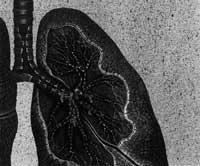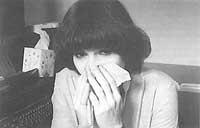Respiratory Pathology (I)
1993/04/01 Agirre, Jabier - Medikua eta OEEko kidea Iturria: Elhuyar aldizkaria
The respiratory system, like an anatomical system, consists of nose and nasal cavities, pharynx, larynx, trachea or cowbell, bronchioles and lungs. Let's see one by one the main details of each of the parts or parts.
Nose Nose Nose Nose Nose
In the nose, the air we breathe suffers three consecutive processes: first it is heated due to the abundance of blood vessels in the nasal cavities; it is moistened thanks to the aqueous content of the nasal mucus; and finally, when passing through the hairs of the nostrils and by the mucus, these act as filter, being adhered the particles and germs that contain the air. Later, thanks to the special movement of the cilia of the mucosa, these particles and residues will be transferred to the pharynx.
Traquea
Once the trachea is finished, it branches into two cylindrical tubes, called main bronchi. They have a diameter of 10-15 mm and go towards the lungs, which are accessed by the center. The right bronchus is divided into three lobular bronchi and the left bronchus is divided into two. These lobular bronchi are of medium caliber with large cartilage plates along with numerous mucosecretive glands.

When each lobular bronchus has entered its lobe “su”, it is re-branched, giving terminal bronchi. They are thinner in calibre than the previous ones. The final ramifications of the bronchi are bronchioles (tubes with a caliber equal to or less than 1 mm, without cartilage). Following the bronchioles are the alveoli, small sacks created by lung tissue. In them, the gaseous exchange of the breath occurs, converting the venous blood into arterial blood.
Trachea, bronchi, and bronchioles undergo major diameter changes during respiratory movements. The air lengthens and expands when breathing (inspiration) and when expelling (expiration) occurs backwards. In the investigations carried out with X-rays it has been possible to verify that along with these movements there are other movements (wavelengths) very appropriate for the elimination of strange particles generated with the air.
All these tubes are covered by two types of cells: those that secrete mucus and those that have a kind of hair. The mucus moistens the air, in addition to trapping dust and strange particles. The hairs or silos have a coordinated movement, like punishment, pushing the mucus towards the trachea and from here with the reflection of the throat these particles will be eliminated.
Lungs Lungs
The lungs are inside the chest box, covered by membranes called pleura. They have cone shape and are on the diaphragm. The space between both lungs is called mediastinum and in it are the heart and the main blood vessels.
The internal structure of the lung is formed by alveoli, a very fine wall canecillos, which give shape to a rich lung. When taking the air, the lungs expand and the outside air enters the alveoli. In them, the gaseous exchange with blood circulates through the blood capillaries that surround the alveolar wall. In other words, oxygen passes into the blood while it is inserted into the carbon dioxide and other residues. In the expiration, that is, when we throw air, the lung contracts and the alveoli empty. In this way, toxic gases are eliminated.
Taking into account the huge amount of air that passes through the lungs throughout the day, it is easy to understand that the toxic effect of the components that make up it can affect the lungs by responding to the lung with cough, choking, and expectoration.
Waterfall
Mucosal secretion of the nasal and throat epithelial cover is only excessive. And why does it happen? Normally the main causes are cooling or hoarseness and “allergic” diseases such as ear fever.
In normal conditions, this epithelial cover flows only mucosa sufficient to maintain the humid medium, but in case of infection or irritation, an excess of liquid flows with the intention of cleaning or neutralizing the irritant, which causes a low nasal ventilation and mucous flow. In the back of the mouth may appear sensation of blockage and sneezing. The waterfall has no extreme gravity and disappears between 2 and 4 days.
But when the cooling is strong, it is common to find hoarseness and/or cough with white caraisa from the lungs. When these are green, brown, or yellow, there is probably bronchitis and it is advisable to go to the doctor, since it may be necessary to take antibiotics. This complication is more common in people who have already suffered bronchitis or asthma.

In children, when the cold lasts longer than a few days, with this annoying sensation of nasal blockage, the doctor should think that adenoids have increased in size. Inhalations (with menthol vapor in children older than 7 years) and nasal decongestion or aerosols (with ephedrine, for example) improve short-term symptoms, but should not be used in a few days. Ephedrine, for example, causes vasoconstriction of the blood vessels of the nose. Therefore, the blood supply is reduced and the leaks are reduced.Antibiotics have no influence on the treatment of the waterfall, since normally these processes are of viral origin.
Bronchitis and bronchitis
Bronchitis is inflammation of the mucosa of the bronchus, with a higher mucosal secretion. Two types of bronchitis are considered: acute and chronic. The acute one starts abruptly and is usually resolved in a few days. Bronchitis is considered chronic when cough and caraisa are more than 90 days a year (not necessarily consecutive) and more than 2 consecutive years.
Acute bronchitis is due to a cataract of upper respiratory tract (nasal and pharynx) due to a series of infectious agents (usually virus) and harmful alterations of the ambient temperature. Physical or chemical irritants can also occur by accidental inhalation.
The factors that contribute to the cronification of acute bronchitis are, according to their importance, tobacco, air pollution and infections.
Acute bronchitis occurs mainly in winter, especially in children, the elderly and smokers.
Chronic bronchitis is the most common disease in men from the age of 50. It is observed more in cold climates and especially in large cities.
Acute bronchitis grows with headache, muscle aches, fever, and cough. The cough at first is dry, which is repeated again and again, but soon karkaiss will arrive. The fever lasts between 4 and 5 days and cough a few more days.
Chronic bronchitis is characterized by the abundance of cough and thistle, along with a greater ease of getting respiratory infections. Respiratory difficulty, bronchial obstruction levels and the existence or not of lung alterations (such as emphysema) are the ones that will provide us. When a bacterial infection occurs, the process worsens and decreases the level of oxygen in the blood, so the skin can take bluish coloration.

It is recommended that patients with acute bronchitis remain in bed avoiding irritating factors such as tobacco. Antithermal agents (to lower the fever) and antitysigens (especially in dry cough) improve the general condition of the patient.
Chronic bronchtics should completely discard tobacco and contaminated environments. Vaccines (anticatarrales) are very useful in autumn-winter. In some cases it is necessary to use antibiotics in treatment (even for a long time) to reduce the severity and duration of respiratory infections.
Consultation with the doctor
A tube with a light is inserted through the mouth to see the bronchi. What is basically this test?
Bronchoscopy is a test that allows to see inside the trachea and thick bronchi, while this technique can be used to obtain material for biopsies. It is also very useful for extracting foreign bodies that have been accidentally ingested (or rather inhaled).
The procedure consists of introducing through the mouth a flexible tube provided with a lighting system that reaches the inside of the bronchi. To avoid nausea, local anesthesia is necessary in the throat.
Bronchoscopy is very useful when X-rays show shadows in the lungs (although the reason is not very clear) or in cases of false cough without clear explanation. Bronchoscopy is usually used when diagnosis has not been clarified by less aggressive methods (X-rays, analysis of catholicism, etc. ).
Is it true that in large cities there are more bronchial patients than in rural areas?
Yes, indeed, chronic bronchitis is much more frequent in industrial areas and large cities than in rural areas, due to the incidence of air pollution in this disease. It has been shown that there is a direct relationship between the sulphur anhydride content of air and mortality rates in this region by chronic bronchitis. Repeated inhalation of irritating gases (although not very high), damages the inner lining of the bronchi facilitating the interruption of leaks (and subsequent infection).
Can the state of the bronchi be seen with a simple x-ray or does a more complex study need?
A normal chest x-ray does not allow to see the bronchi accurately. To do this, a bronchography is necessary, that is, a radiographic study of the bronchi that can be done after contrasting the bronchi with an opaque substance to the X-rays. Iodine is injected into the bronchi with a tube that allows to see the bronchial tree of a given zone. However, bronchography cannot be used in recorded patients and it should be taken into account that this technique irritates bronchial coverage. Currently, bronchoscopy has been totally replaced.
When they get up in the morning, smokers tosen and throw numerous caraises. Is that a consequence of tobacco or bronchitis?
The bronchi are covered internally by a thin cell layer. And these cells, once inflamed, are released forming a kind of “mucus” that will be removed with the cough. The smoke of cigarettes is irritating to the bronchi, and many smokers when they get out of bed throw a lot of carais, since at night the secretions accumulate. Probably if they quit smoking these symptoms would disappear or decrease.

In other cases, inreparable lesions occur in the bronchi that force the patient to expel the carcasses repeatedly. Tobacco tolerance is different in each person, but in general it can be said that the smoking habit carries a chronic bronchitis.
Is it possible to avoid or at least not progress chronic bronchitis?
Three are the factors that make bronchitis a chronic disease: tobacco, air pollution, and infections.
The smoker who starts with heavy explosions for long periods of time should leave tobacco. The drowning that the worsened smoker perceives when making certain efforts (previously it supported these efforts well) is an alarm signal that warns him that his breathing capacity has begun to deteriorate.
When the irritating agent is air pollution in the workplace or pollution in large cities it is possible to avoid chronic bronchitis. In these cases, the problem does not depend on oneself, but on the authorities.
The last factor, that of infections, is more difficult to prevent.
On the other hand, inhalation of the mouth and nose is an easy way to prevent bronchial irritation, since the air that is inspired is moistened, heated, and filtered.
Can bronchitis damage long-term breathing capacity?
Yes, of course. Chronic bronchitics suffer less and less physical efforts. At first the greatest efforts (climbing stairs, running) will come out, but over time all movements will be limited. The stacked mucus hinders the advance of the air, which causes choking, since with any effort the cells of the body demand more. Over the years, irreparable lung lesions occur, and a state called pulmonary emphysema appears.
Should bronchitic children play with other children outdoors?
Yes, of course. Often, parents of children prone to bronchitis wear too much clothes, afraid they will come out “cooled”. That is not recommended. On the contrary, it is convenient for these children to play outdoors without too much clothes, otherwise they would sweat. In addition, it is advisable that the child do gymnastics and some sport, since physical exercise hardens the body giving greater resistance to infectious diseases.
Antibiotics. When are they necessary in bronchitis?
They should be used with great care and not only for their possible toxicity. In fact, when not used in the necessary doses, it can happen that some bacteria live instead of dying and are resistant to this antibiotic. Therefore, it is obligatory to follow the indications of the doctor, since only this one will distinguish when it is a normal refrigeration (without the need of antibiotics) and when it is a bacterial infection appeared in addition to the virus. Antibiotics are only useful in recent cases.
Advice for people with bronchitis
- Avoid smoking because tobacco is the main irritant of the bronchi.
- Stroll outdoors breathing deeply.
- Avoid air currents and temperature changes at low. Do not stay long in humid places, clouds, or big cold.
- Avoid strong odors (lacquer, paint) or smoke from cars and factories.
- If you have any allergies, do not have animals at home.
- Good ventilation of the halls. Also working and sleeping.
- Breathing exercises, showers (alternating hot and cold water) and dry brushing improve blood circulation. Inhale vapors and drink plenty of liquid to soften and remove mucus.

Gai honi buruzko eduki gehiago
Elhuyarrek garatutako teknologia




